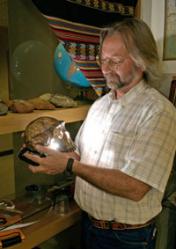Texas State University archaeologist helps scientists better understand evolution
Source - http://haysfreepress.com/2012/10/10/texas-state-university-archaeologist-helps-scientists-better-understand-evolution/

Texas State University professor Britt Bousman and and an archaeology team recently uncovered a bone bed in South Africa. In it they found a human molar and stone tools dating to about one million years ago. (Courtesy Photo)
Paleomagnetism – is that how ancient humans attracted the opposite sex?
No, but it is an important technique that allowed Texas State University professor Britt Bousman, in collaboration with Andy Herries of Australia’s La Trobe University, to date a South African excavation site near Johannesburg.
Bousman and an archeology team led by James Brink, head of the Florisbad Quaternary Research Department at the National Museum in Bloemfontein, South Africa, recently uncovered a bone bed. In it they found a human molar and stone tools dating to about one million years ago.
This finding brought scientists a step closer to understanding human evolution.
Bousman, who holds degrees in Archaeology and Anthropology, said the discovery of the million-year-old site is significant because so little is known of early humans between 1.5 million and 200,000 years ago.
According to Jacopo Moggi-Cecchi from the Universitá di Firenze in Italy, the molar is the oldest human remains to be discovered in South Africa’s Free State Province.
It is believed to be that of either a Homo erectus or perhaps the more primitive Homo habilis. Brink said if they can confirm the tooth is Homo habilis it would be the youngest such remains in Africa. The significance of that result is that the evolution of hominines is more complex than currently understood.
“In southern Africa, we have well-preserved human remains from 4.5 million to about 1.5 million years ago, from Australopithecines, who ate plants and scavenged animal carcasses. But, once hominines such as Homo habilis and Homo erectus started making stone tools and shifted to hunting, the archaeological record thins out in southern Africa. We have huge gaps of missing information between 1.5 million and 200,000 years ago. This finding helps us to fill in the record,” Bousman said.
Bousman was the first archaeologist to date the Cornelia site using paleomagnetic reversals and the molar is the oldest hominine specimen to be found in southern Africa, outside of the Australopithecine caves in northern South Africa.
The molar and stone tools – found in a bone bed probably created by spotted hyenas – were discovered by James Brink and an international team of archaeologists and other scientists – including Bousman – from South Africa, Australia, Great Britain, France, Italy and the United States. Details of the discovery were published recently in the Journal of Human Evolution.
Bousman has conducted archaeological studies in South Africa since the 1970s, studying the physical, environmental and behavioral changes that catalyzed the dispersal of modern humans.
“Being able to date the human remains at Cornelia to one million years ago has been perhaps the most exciting experience of my career,” he said.